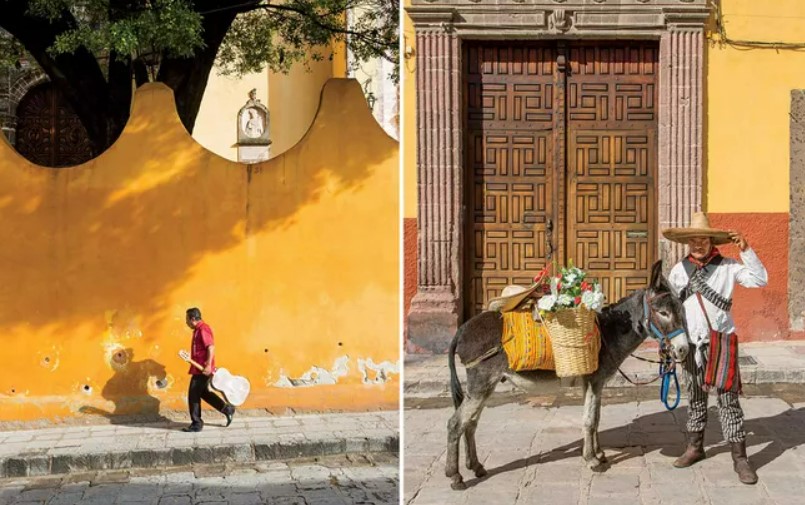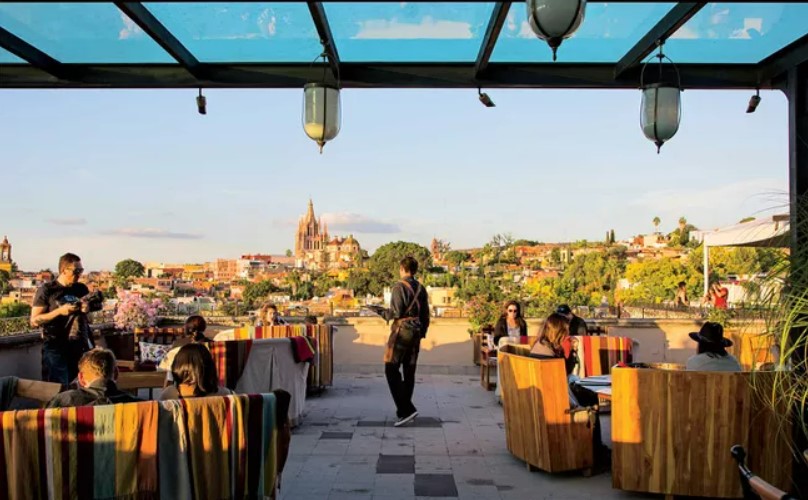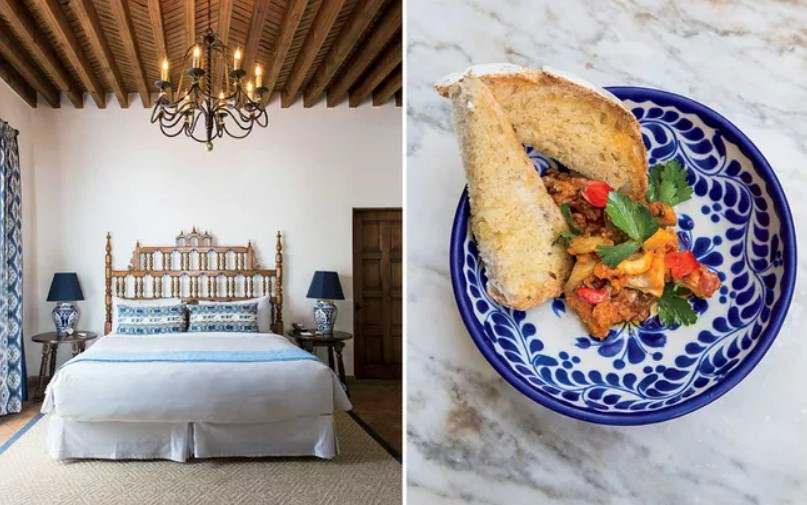How San Miguel Became Mexico’s Most Enchanting Destination — and the 2021 World’s Best City
Historical circumstance left this colorful city remarkably intact. Thanks to first-class restaurants, outstanding hotels, and beguiling architecture, it's become popular with visitors, who arrive in search of its ineffable magic.Aldama Street, one of the many romantic alleys that make San Miguel de Allende's Centro a great place to wander. PHOTO: LINDSAY LAUCKNER GUNDLOCK
With its obsidian-lined walls that narrow to a high, vaulted ceiling, the six-seat tasting room of the tequila company Casa Dragones feels like a sleek, pocket-size chapel from the future. Since it opened in 2016, it has become an essential stop in the Mexican colonial town of San Miguel de Allende, so I headed there my first night to pay respects to the tequila gods. Now I was sitting at the altar-like bar, admiring a long-stemmed crystal glass of Casa Dragones Joven, which the brand bills as a "sipping tequila." Admiring her own glass was the manager, Eva Corti, an effortlessly stylish Italian with straight-cut blond bangs. "See how clear it is?" she asked. "No imperfections." We passed our noses from rim to rim, searching out fragrances of citrus and spice, flowers and wood. Then we sipped, and warm tequila fuzzies floated through me.
After we'd done some more sipping, Corti told me about herself. Since moving to Mexico six years ago, she has lived in Mexico City, Oaxaca, Puerto Vallarta, and the Yucatán, but she said it wasn't until arriving in San Miguel that she felt like she was home. The place has that effect on people. In fact, San Miguel de Allende was just named the world's best city in the 2021 World's Best Awards, topping the travel charts thanks to its exceptional architecture, revelatory hotels, and infectious sense of community.
San Miguel was ranked as the second best city in the 2020 World's Best Awards and took the top spot in 2017 and 2018. It's the type of place that our readers come back to, year in and year out, and a destination where many travelers want to put down roots. MTV founder Bob Pittman, who launched Casa Dragones in 2009 with the Mexican tequila entrepreneur Bertha González Nieves, bought a house in San Miguel days after his first visit. Americans have been drawn to its sloping cobblestoned lanes since a shy Chicagoan named Stirling Dickinson became the director of the Escuela Universitaria de Bellas Artes, a local art institute, with the idea of turning San Miguel into an international arts colony. After World War II, veterans came to study there on the G.I. Bill, sending word of its wonders back to the States. Before long, it was a top vacation and retirement destination for Americans. And now, it's the top city destination in the world, according to Travel+Leisure readers.
The arts are still central to the appeal of San Miguel, where the gallery-to-resident ratio might exceed that of Santa Fe, New Mexico (which it has more than a little in common with). Over the past decade, however, San Miguel has also blossomed as a gastronomic hub, thanks to the arrival of destination restaurants like Moxi and Áperi. Perhaps not coincidentally, a number of fine hotels have also opened, introducing a true luxury quotient to a place that once catered mostly to backpackers and bohemians. The town's growing popularity has led to some hand-wringing about traffic and touristification, but I found these to be minor issues and, to be honest, I got a kick out of the mariachis and balloon vendors in front of the Parroquia de San Miguel Arcángel, the soaring neo-Gothic cathedral you've probably seen if you've ever seen a picture of San Miguel.
Anyway, a few tchotchke sellers can't sabotage San Miguel's most appealing trait, which is its gloriously anachronistic cityscape: the Spanish-colonial architecture that glows as the sun sinks over the central Mexican highlands, the hundreds of brightly colored doors leading to languid private courtyards, and, of course, the Parroquia, around which the entire town revolves. All this colonial perfection is due largely to the quirks of San Miguel's long history, which is almost palpable as you wander its plazas and churches and the endless covered market that snakes though its middle. Under Spanish rule, San Miguel had a larger population than New York City, but it lost prominence in the 19th century after the Mexican War of Independence and was practically abandoned by the end of the Mexican Revolution in 1920. As a result, historic San Miguel has survived intact.

From left: A musician walks past the bright exterior of the Church of the Immaculate Conception on Canal Street; a man and his donkey on Correo Street, near the Parroquia de San Miguel Arcángel. PHOTO: LINDSAY LAUCKNER GUNDLOCK
"It's an organized city — not like other Mexican cities," said Victor Martinez, the sous-chef at Luna Rooftop Tapas Bar, at the Rosewood San Miguel de Allende. Other San Migueleños I met took similar pride in their town's singularity, boasting that it embodies many of Mexico's best qualities (The food! The culture! The weather! The people!) and none of its worst; again and again, I was told that San Miguel is one of the safest places in Mexico.
One morning, Martinez took me to Rancho La Trinidad, a 10-acre organic farm on the outskirts of town from which the Rosewood's restaurants (and many others) source much of their produce. Its founding in 1995 by Carl Jankay, a former Campbell's Soup Company executive from the U.S., marked the beginning, Martinez told me, of San Miguel's "awakening of consciousness" with regard to food. Iliana Lanuza, Jankay's stepdaughter, led us to the crops that were in season — beets, squash blossoms, spaghetti squash, leeks, carrots — which we harvested under the watchful eye of the mule that tills the fields. Then we headed back to the hotel to cook our own farm-to-table meal at Les Pirules, the Rosewood traditional Mexican outdoor kitchen.
Martinez, who is originally from Mérida and oozes enough rakish charm to pass for a telenovela star, guided me through some basic principles of Mexican cooking. Before I knew it we had produced four beautiful dishes: beets with kumquats, almonds, and basil; spaghetti squash in a Parmesan cream sauce; Mexican-style rice with broccoli rabe; and braised pork shank in a quick mole topped with squash blossoms. As we ate, I asked Martinez how he felt about the recent global popularity of Mexican cuisine. "I think it's great," he said. "But I could never pay so much money for tacos."
Though I ate my other meals at the Rosewood alone, they were no less lovely. At the expansive main restaurant, 1826, another of the spots that established San Miguel as a culinary destination earlier this decade, I was treated to a procession of playful twists on tradition: a ceviche in a tequila-spiked sangrita, lobster ravioli in a butter sauce with Mexican truffles, suckling pig in mole. At Luna, arguably the best rooftop bar in this terrace-mad town, I ate guacamole and drank a Casa Verde (Casa Dragones with limoncello, lemon juice, kiwi, and celery) while watching guests snap pics of the Parroquia as it turned pink in the honeyed late-afternoon light.

The view of the Parroquia de San Miguel Arcángel from Luna Rooftop Bar, at the Rosewood San Miguel de Allende. PHOTO: LINDSAY LAUCKNER GUNDLOCK
For breakfast one day, I walked over to an all-day café called Lavanda to join the crowd that was waiting on the narrow sidewalk for it to open. The weather was brisk and the restaurant wasn't insulated, but the heat lamps and the cool air only added to the ramshackle appeal of the place, with its climbing vines and rattan furniture. Befitting the restaurant's name, my cappuccino came with a sprig of locally grown lavender. My bowl of chilaquiles was delicate, spicy, and comforting, all at the same time.
The restaurant had a youthful, unfussy approach to cooking that I saw a lot in San Miguel, including at a place called Trazo 1810. You can't get much more San Miguel than this: to reach the restaurant, you walk through an art gallery and ascend in the elevator of the Hotel Casa 1810; if you wish, you can dine on the fourth-floor terrace. As I ate my cayenne-rubbed roast chicken and gnocchi, the Parroquia seemed to exert a magnetic pull on me, like a benign version of the Eye of Sauron.
The central tension of a stay at the Rosewood San Miguel de Allende is your simultaneous desire to explore the city around you and to relax in one of the white cabanas by the pool. (Solution: book a longer stay.) The 13-acre modern hacienda, whose arched colonnades and faded ocher exteriors belie the hotel's newness, has 67 generous rooms, all with lovely dark-wood colonial-style furniture and private gardens or terraces; mine had its very own rooftop with a plunge pool and a view of the Parroquia. There is lavender everywhere: in the garden along the path to the pool, in the butter at 1826, in the products at the Sense Spa.
But while this little utopia raised the bar for hotels in San Miguel, the town's pioneering luxury property is the Casa de Sierra Nevada, which Belmond acquired in 2006 and completely overhauled in 2018. Unlike the Rosewood, which sits at a slight remove from the city, Casa de Sierra Nevada, a Belmond Hotel, is very much of the city. It consists of a cluster of colonial mansions (the main building, Casa Principal, was once the residence of the archbishop of San Miguel) in the Centro, each with half a dozen or so guest rooms around a central courtyard that's walled off from the street, so the vibe is of a private sanctuary right in the middle of everything. The 37 rooms have a slightly wabi-sabi quality, with stone fireplaces, copper-lined tubs, herringbone wood flooring, and regional textiles that all add up to a very authentic kind of elegance. As part of its makeover, the hotel, whose Sazón culinary school ushered in the local mania for cooking classes, has added something called the Artist's Corner, where a resident artist teaches painting classes and meets guests for gallery tours.
Belmond's renovation coincided with several openings that further diversify the hotel options in San Miguel. These include L'Ôtel at Dôce 18 Concept House, part of the same artisan-forward mini-mall that houses the Casa Dragones tasting room, and Casa Blanca 7, a tiny Moroccan-inflected spot near El Jardín, the central plaza. The two latest go in very different directions: Live Aqua Urban Resort San Miguel de Allende, the fifth location for the Mexican brand, is now the biggest hotel in town, with 153 rooms. Situated in a renovated contemporary hacienda-style building in front of a centuries-old dam, it's a curious mix of arty futurism and welcoming homeyness. With its repeating archways, vast sunlit expanses, and monolithic sculptures strewn across the grounds, it has the surreal feeling of a de Chirico painting — and yet the reception desk doubles as a bakery, and every Sunday there's an enormous brunch in the courtyard.
By contrast, Hotel Amparo, in an 18th-century mansion where a mayor once lived, has just five rooms. Owned by a pair of Houston art collectors, it contains an appealing mix of modern works and antiques. Naturally, there is a traditional open kitchen where guests can attend cooking workshops, and, naturally, there is a rooftop terrace, which Bernardo Morales, the hotel's assistant general manager, told me would soon become a small, wine-focused restaurant.

From left: An antiques-filled guest room at the Belmond Casa de Sierra Nevada; mushrooms in an escabeche at Hotel Amparo. PHOTO: LINDSAY LAUCKNER GUNDLOCK
I'd already had breakfast, but Morales insisted I have another. As I sat in the courtyard eating chicken chilaquiles and a delicate parfait, listening to the Beatles and the sound of the fountain, and watching through the front gate as the world went by outside, I couldn't imagine a better place to be.
Because I wanted to see the landscape around San Miguel, the Casa de Sierra Nevada, a Belmond Hotel arranged for me to go horseback riding at Rancho Xotolar, about 45 minutes outside town. I was picked up by Lio Morín, a smiling cowboy who spoke English with a Southern lilt, thanks to many years spent in Oklahoma. He'd recently moved home to the ranch where he grew up, which he said his great-grandfather, a silver miner from Guanajuato, had purchased nearly 70 years ago. We turned off the highway at the Cañada de la Virgen, an Otomi archaeological site that the Mexican government opened for tourism in 2011, and bumped down a narrow dirt road, passing giant crows perched in the acacia trees, until we reached the sprawling compound where Morín's enormous extended family lives. He pointed out the small school attended by all the kids on the ranch.
With Felíx, Morín's uncle, and Roberto, his cousin, we rode out onto the mesa, threading through cactus and shrub brush. After stopping to take in the view of San Miguel, we descended on a narrow trail carved into a steep arroyo. It started to rain, so my companions gave me a canvas poncho to go with my straw sombrero. I almost felt like a real caballero as my horse scrabbled down the wet rocks, the guys behind me shouting Mexican folk songs. At the bottom, we forded a small river, then galloped through it, whooping and kicking up spray.
It was dusk when we got back to the compound, but there were no lights on. Morín explained that, to this day, Rancho Xotolar has no electricity. "When we want to watch TV, we hook it up to a car battery," he said. We headed over to a small building with an open kitchen where his mother and sister were preparing a meal over a fogón, a traditional wood oven. In the gathering darkness, we ate queso fresco made from that morning's cow's milk, a wonderfully astringent nopal salad, a fiery pico de gallo, beans, rice, sopes, and warm, soothing enchiladas. It was as delicious as anything I ate in town.
Another thing you can do if you want to see the landscape around San Miguel is take a taxi up the winding roads above the city to the Charco del Ingenio, a 220-acre nature preserve on a site that was once a water mill. I wandered alone past burly indigenous cacti, breathing in the tranquil sweetness of the place. A flock of ducks landed on Las Colonias reservoir, which sits at the center of the gardens. I decided to cross the old dam to check out a ruined hacienda I'd seen on my map.
A couple crossed from the other side, the first people I'd seen since entering the preserve. Just as my lips started to make the b in buenas tardes, the man said my name.
It was Bernardo Morales, from Hotel Amparo. "It's my first time here," he told me. "I just moved to San Miguel three months ago."
We agreed that San Miguel really must be a small town if we could run into each other here, and that we'd have to run into each other again soon. Then we went our separate ways.
A Thumbnail Guide to San Miguel
Spend at least four nights to soak up the town's many pleasures. San Miguel, which is roughly equidistant from Guadalajara and Mexico City, is also a great part of a larger central Mexico itinerary.
Getting There
San Miguel isn't a particularly quick trip, as flying from most U.S. airports will require a layover, and once you're on the ground there will be a significant drive. The two nearest airports are Del Bajio, in León, about 90 minutes away, and Querétaro, about 75.
Hotels + Restaurants
he luxury hotels that best showcase the region's traditional aesthetics are the Belmond Casa de Sierra Nevada (doubles from $275), in the Centro, and the Rosewood San Miguel de Allende (doubles from $300), home to the popular Luna Rooftop Tapas Bar. Hotel Amparo (doubles from $325) is the most intimate of San Miguel's many newcomers, and great for buyouts. Travelers seeking small hotels should also consider L'Ôtel at Dôce 18 Concept House (doubles from $355) or Casa Blanca 7 (doubles from $342). By contrast, Live Aqua Urban Resort San Miguel de Allende (doubles from $289) is an artsy citadel just north of the Centro.
Expect to visit other hotels when you dine out. Moxi (entrées $9–$16), at Hotel Matilda, and Áperi (tasting menus from $62), at Dos Casas, serve locally inflected haute cuisine, while Trazo 1810 (entrées $14–$30), at Hotel Casa 1810, offers relaxed, youthful cooking. Hit Lavanda Café (entrées $5–$6) for breakfast and El Pegaso (entrées $4–$18) for Mexican classics. Make an appointment at the Casa Dragones Tasting Room for the tastiest tequila in town.
Activities
Many hotels can arrange half-day riding tours at Rancho Xotolar. Afterward, visit the ancient Otomi pyramids of Cañada de la Virgen, nearby. El Charco del Ingenio, San Miguel's botanical garden, is a great way to get away without going far.












